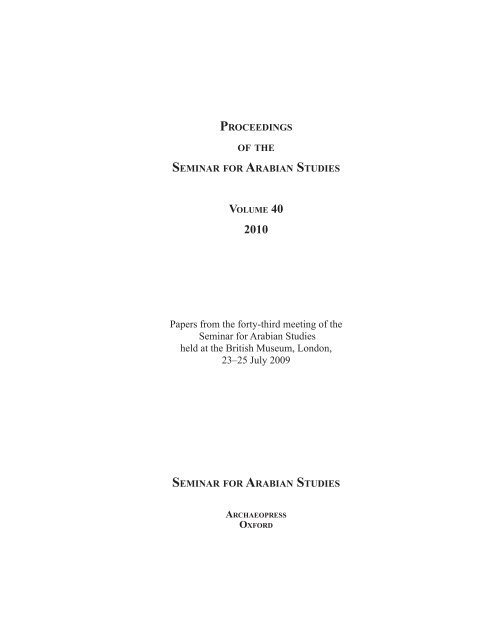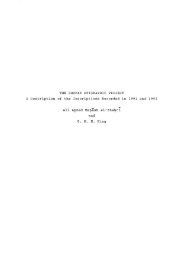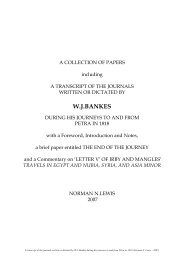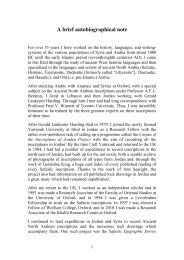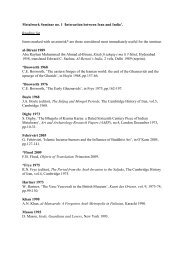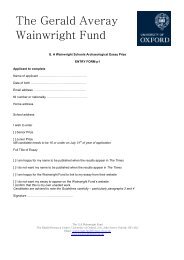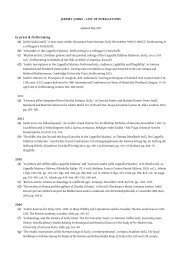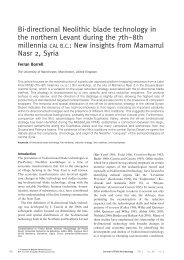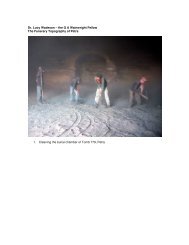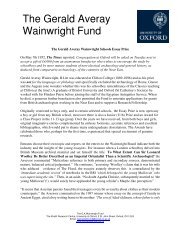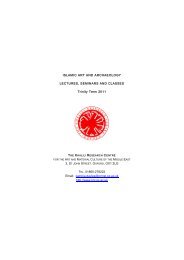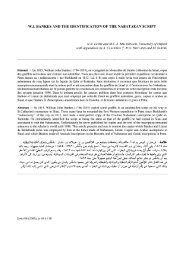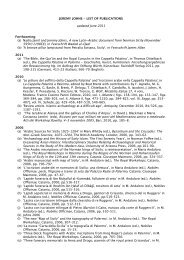Papers from the forty-third meeting of the Seminar for Arabian ...
Papers from the forty-third meeting of the Seminar for Arabian ...
Papers from the forty-third meeting of the Seminar for Arabian ...
You also want an ePaper? Increase the reach of your titles
YUMPU automatically turns print PDFs into web optimized ePapers that Google loves.
Proceedings<br />
<strong>of</strong> <strong>the</strong><br />
seminar <strong>for</strong> arabian studies<br />
Volume 40<br />
2010<br />
<strong>Papers</strong> <strong>from</strong> <strong>the</strong> <strong><strong>for</strong>ty</strong>-<strong>third</strong> <strong>meeting</strong> <strong>of</strong> <strong>the</strong><br />
<strong>Seminar</strong> <strong>for</strong> <strong>Arabian</strong> Studies<br />
held at <strong>the</strong> British Museum, London,<br />
23–25 July 2009<br />
seminar <strong>for</strong> arabian studies<br />
archaeoPress<br />
ox<strong>for</strong>d
Orders <strong>for</strong> copies <strong>of</strong> this volume <strong>of</strong> <strong>the</strong> Proceedings and <strong>of</strong> all back numbers should be sent to<br />
Archaeopress, Gordon House, 276 Banbury Road, Ox<strong>for</strong>d OX2 7ED, UK.<br />
Tel/Fax +44-(0)1865-311914.<br />
e-mail bar@archaeopress.com<br />
http://www.archaeopress.com<br />
For <strong>the</strong> availability <strong>of</strong> back issues see <strong>the</strong> <strong>Seminar</strong>’s web site: www.arabianseminar.org.uk<br />
<strong>Seminar</strong> <strong>for</strong> <strong>Arabian</strong> Studies<br />
c/o <strong>the</strong> Department <strong>of</strong> <strong>the</strong> Middle East, The British Museum<br />
London, WC1B 3DG, United Kingdom<br />
e-mail seminar.arab@durham.ac.uk<br />
The Steering Committee <strong>of</strong> <strong>the</strong> <strong>Seminar</strong> <strong>for</strong> <strong>Arabian</strong> Studies is currently made up <strong>of</strong> 13 members. The<br />
Editorial Committee <strong>of</strong> <strong>the</strong> Proceedings <strong>of</strong> <strong>the</strong> <strong>Seminar</strong> <strong>for</strong> <strong>Arabian</strong> Studies includes 6 additional members<br />
as follows:<br />
STEERING COMMITTEE EDITORIAL COMMITTEE: ADDITIONAL MEMBERS<br />
Dr Robert Carter (Chair)<br />
Dr Mark Beech<br />
Dr Nadia Durrani<br />
Dr Robert G. Hoyland<br />
Dr Derek Kennet<br />
Mr Michael C.A. Macdonald<br />
Dr Ardle MacMahon (Secretary)<br />
Dr Venetia Porter<br />
Dr St John Simpson<br />
Mrs Janet C.M. Starkey (Editor)<br />
Mr Andrew Thompson (Treasurer)<br />
Pr<strong>of</strong>essor Janet Watson<br />
Dr Lloyd Weeks<br />
Pr<strong>of</strong>essor Alessandra Avanzini<br />
Dr Ricardo Eichmann<br />
Pr<strong>of</strong>essor Clive Holes<br />
Pr<strong>of</strong>essor Khaleel Al-Muaikel<br />
Pr<strong>of</strong>essor Dan Potts<br />
Pr<strong>of</strong>essor Christian Robin<br />
Opinions expressed in papers published in <strong>the</strong> Proceedings are those <strong>of</strong> <strong>the</strong> authors and are not<br />
necessarily shared by <strong>the</strong> Editorial Committee.<br />
Typesetting, Layout and Production: Dr David Milson<br />
The Proceedings is produced in <strong>the</strong> Times Semitic New font, which was designed by Paul Bibire <strong>for</strong> <strong>the</strong><br />
<strong>Seminar</strong> <strong>for</strong> <strong>Arabian</strong> Studies.<br />
© 2010 Archaeopress, Ox<strong>for</strong>d, UK.<br />
All rights reserved. No part <strong>of</strong> this publication may be reproduced, stored in a retrieval system, or transmitted,<br />
in any <strong>for</strong>m or by any means, electronic, mechanical, photocopying, recording, or o<strong>the</strong>rwise, without <strong>the</strong><br />
prior permission <strong>of</strong> <strong>the</strong> publisher.<br />
ISSN 0308-8421<br />
ISBN 978-1-905739-33-2
Proceedings <strong>of</strong> <strong>the</strong> <strong>Seminar</strong> <strong>for</strong> <strong>Arabian</strong> Studies 40 (2010): xi–xii<br />
In memoriam<br />
Geraldine King<br />
Geraldine Margaret Harmsworth King died on 12 October 2009 after a long and courageous battle with cancer. She<br />
was fifty-five and leaves a daughter, Ellie, who is thirteen. Geraldine served as Secretary <strong>of</strong> <strong>the</strong> <strong>Seminar</strong> and editor <strong>of</strong><br />
<strong>the</strong> Proceedings, between 1992 and 1996. She organized <strong>the</strong> annual <strong>meeting</strong>s in Ox<strong>for</strong>d, Cambridge, Manchester, and<br />
London and all those who attended <strong>the</strong> <strong>Seminar</strong> in those days will remember her kindness, efficiency, and extremely<br />
hard work. When <strong>the</strong> news <strong>of</strong> her death was circulated to all those on <strong>the</strong> <strong>Seminar</strong>’s mailing list I received an enormous<br />
number <strong>of</strong> warm messages <strong>from</strong> those who remembered her with gratitude and affection.<br />
Geraldine was an excellent scholar who played an important part in deepening our understanding <strong>of</strong> <strong>the</strong> Ancient<br />
North <strong>Arabian</strong> inscriptions and providing a much sounder basis <strong>for</strong> <strong>the</strong>ir study. She undertook a number <strong>of</strong> expeditions<br />
to <strong>the</strong> deserts <strong>of</strong> Jordan and Syria and <strong>the</strong> mountains <strong>of</strong> Dh<strong>of</strong>ar, recording thousands <strong>of</strong> inscriptions which she <strong>the</strong>n<br />
worked on patiently and perceptively over many years.<br />
Be<strong>for</strong>e she went up to <strong>the</strong> University <strong>of</strong> Durham to read Philosophy in <strong>the</strong> early 1970s, Geraldine had spent a year<br />
teaching in Ethiopia. After graduating <strong>from</strong> Durham, she spent ano<strong>the</strong>r year teaching, this time in Sudan. While <strong>the</strong>re,<br />
she began to learn spoken Arabic and on her return to <strong>the</strong> UK enrolled <strong>for</strong> a degree course in Arabic at <strong>the</strong> School <strong>of</strong><br />
Oriental and African Studies, University <strong>of</strong> London. As part <strong>of</strong> this course, she spent a year in Amman at <strong>the</strong> University<br />
<strong>of</strong> Jordan; it was <strong>the</strong>re that Annie Searight and I first got to know her and she became a life-long friend.<br />
Having completed her SOAS degree she came to work with me at Yarmouk University on <strong>the</strong> Corpus <strong>of</strong> <strong>the</strong><br />
Inscriptions <strong>of</strong> Jordan Project which I had set up <strong>the</strong>re, at <strong>the</strong> behest <strong>of</strong> Pr<strong>of</strong>essor Mahmud al-Ghul. Geraldine worked<br />
on <strong>the</strong> Project <strong>for</strong> almost five years, recording large numbers <strong>of</strong> Safaitic inscriptions and creating much <strong>of</strong> <strong>the</strong> academic<br />
infrastructure <strong>for</strong> <strong>the</strong> Project.<br />
In 1986 and 1987, she single-handedly recorded over 1500 Hismaic inscriptions in <strong>the</strong> south <strong>of</strong> Jordan. She<br />
produced an edition <strong>of</strong> most <strong>of</strong> <strong>the</strong>se in her doctoral <strong>the</strong>sis at SOAS, which was completed in 1990. However, her<br />
<strong>the</strong>sis was much more than an edition, <strong>for</strong> in it she undertook <strong>the</strong> first detailed analysis <strong>of</strong> every aspect <strong>of</strong> this type <strong>of</strong><br />
Ancient North <strong>Arabian</strong> inscription, thus making it possible to separate it <strong>from</strong> <strong>the</strong> “Thamudic pending file” in which,<br />
under <strong>the</strong> name “Thamudic E”, it had languished since <strong>the</strong> 1930s. Although she never published her <strong>the</strong>sis, it quickly<br />
became, and has remained, <strong>the</strong> standard reference work on <strong>the</strong> subject; photocopies <strong>of</strong> it can be found in most academic<br />
libraries dealing with ancient Jordan and Arabia.<br />
Between January and March 1989, Geraldine and Becca Montague spent six weeks in <strong>the</strong> basalt desert <strong>of</strong> nor<strong>the</strong>astern<br />
Jordan in freezing temperatures, recording inscriptions and sites which were about to be destroyed by bulldozers<br />
clearing a network <strong>of</strong> tracks <strong>for</strong> <strong>the</strong> enormous machines searching <strong>for</strong> oil-bearing rocks. In <strong>the</strong> process, Geraldine<br />
recorded over 3700 inscriptions and a huge number <strong>of</strong> rock drawings, and Becca over 400 sites (see PSAS 20, 1990:<br />
55–78). Geraldine had almost finished preparing <strong>the</strong> inscriptions <strong>for</strong> publication when she died.<br />
In <strong>the</strong> 1980s and early 1990s, ΚAlī AΉmad al-MaΉāsh al-ShaΉrī discovered hundreds <strong>of</strong> painted and carved texts<br />
in <strong>the</strong> mountains <strong>of</strong> Dh<strong>of</strong>ar, in a previously unknown <strong>for</strong>m <strong>of</strong> <strong>the</strong> South Semitic script (see PSAS 21, 1991: 173–191).<br />
He asked Geraldine to mount an expedition with him to record <strong>the</strong>se and in 1991 and 1992 <strong>the</strong>y recorded some 900.<br />
Geraldine wrote a very full report and even designed a font to represent <strong>the</strong> letters <strong>of</strong> <strong>the</strong> inscriptions so that she could<br />
prepare a concordance, a prerequisite <strong>for</strong> any decipherment.<br />
I am happy to say that, within <strong>the</strong> next two years, her <strong>the</strong>sis and <strong>the</strong>se two o<strong>the</strong>r large collections <strong>of</strong> inscriptions will<br />
be published online on <strong>the</strong> website <strong>of</strong> <strong>the</strong> new Ancient Arabia: Languages and Cultures (AALC) project <strong>of</strong> <strong>the</strong> Khalili<br />
Research Institute, University <strong>of</strong> Ox<strong>for</strong>d.<br />
In 1995 and 1996 she joined <strong>the</strong> first two seasons <strong>of</strong> <strong>the</strong> Safaitic Epigraphic Survey Programme, which recorded<br />
over 4000 Safaitic inscriptions in sou<strong>the</strong>rn Syria. However, in December 1996 her daughter, Ellie, was born and <strong>from</strong><br />
<strong>the</strong>n on Geraldine concentrated on <strong>the</strong> more important and rewarding role <strong>of</strong> being a mo<strong>the</strong>r.
xii<br />
Geraldine was not only an excellent scholar and an indefatigable field-worker, but also a warm, loyal, generous, and<br />
affectionate friend. She could always be relied on in any circumstances, however gruelling, and showed great courage<br />
and endurance when required. She was also gentle and funny and very kind. She will be fondly remembered by all who<br />
were lucky enough to come into contact with her.<br />
Michael Macdonald<br />
In memoriam Geraldine King<br />
Geraldine King<br />
1954-2009


